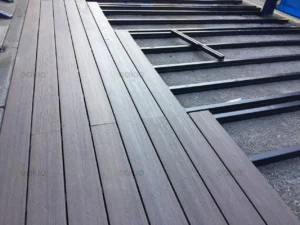Deck Taping: Essential Protection for Your Deck’s Substructure
A deck is a valuable addition to any home, providing an outdoor space for relaxation and entertainment. However, maintaining the integrity and longevity of a deck requires more than just choosing the right decking boards. Protecting the substructure, which is often made of traditional lumber, from moisture and decay is crucial. This is where deck taping comes into play.
In this article, we will explore the purpose, benefits, and application process of deck taping, and why it is an essential step in ensuring the long-term health of your deck.
What Is Deck Taping?
Deck taping involves the use of a water-resistant butyl adhesive tape that is applied to the joists and other substructural elements of a deck. This tape serves a critical function by preventing moisture from penetrating the deck’s frame. While composite decking boards are typically resistant to weather and moisture, the traditional lumber used for the joists and ledger is susceptible to water damage. Deck taping provides a protective barrier that keeps the substructure dry and extends its lifespan.
Benefits of Deck Taping
The application of deck tape offers several significant benefits:
1. Saves on Future Maintenance/Replacement Costs
By preventing moisture from reaching the wooden substructure, deck taping reduces the likelihood of rot and decay. This means fewer repairs and replacements over time, saving homeowners money in the long run.
2. Increases Deck Longevity
A deck’s lifespan is directly linked to the health of its substructure. Protecting the joists with deck tape helps ensure that the entire deck remains sturdy and functional for many years.
3. Improves Structural Integrity for Long-Term Enjoyment
Moisture can weaken wood, compromising the structural integrity of a deck. Deck taping helps maintain the strength and stability of the substructure, allowing homeowners to enjoy their deck without worry.

When to Use It
1. During Initial Deck Construction
Why:
– Applying deck tape during the initial construction of a deck provides a proactive measure to protect the substructure from the start.
– Traditional lumber, commonly used for joists and ledgers, is highly susceptible to moisture damage, leading to rot and decay over time.
How:
– Apply tape to clean, dry lumber before assembling the deck.
– Ensure that all joists, beams, and other structural components that might come into contact with moisture are covered with the tape.
2. During Deck Renovations or Repairs
Why:
– When renovating or repairing an existing deck, it is essential to inspect the substructure for signs of moisture damage.
– Adding or replacing deck tape can significantly extend the life of the deck by preventing further water penetration.
How:
– Remove any damaged or decayed wood.
– Clean and dry the remaining lumber.
– Apply deck tape to the exposed substructure before proceeding with additional repairs or renovations.
3. In High Moisture Environments
Why:
– Decks in regions with high humidity, frequent rain, or near water bodies are at greater risk of moisture infiltration.
– Using deck tape in these environments provides an added layer of protection against constant exposure to moisture.
How:
– Ensure that the tape is applied thoroughly to all potential points of water ingress.
– Regularly inspect and maintain the tape to ensure it remains effective.
4. When Using Composite Decking
Why:
– Composite decking boards are resistant to weather and moisture, but the underlying structure, often made of traditional lumber, still needs protection.
– Applying deck tape ensures the longevity of both the composite boards and the wooden substructure.
How:
– Before installing composite decking boards, apply deck tape to the joists and other structural components.
– This helps to create a moisture barrier that complements the durability of the composite boards.
5. As Part of Routine Deck Maintenance
Why:
– Regular maintenance of a deck includes checking the condition of the substructure and ensuring it remains protected from moisture.
– Reapplying or replacing deck tape as part of routine maintenance can prevent small issues from becoming major problems.
How:
– Periodically inspect the deck tape for signs of wear or damage.
– Replace any worn or damaged tape to maintain an effective moisture barrier.
Essential Steps When Using Deck Taping
Applying deck tape is a straightforward process, but it must be done correctly to ensure maximum effectiveness. Here are the steps to follow:
1. Clean and Dry Lumber
Before applying the tape, make sure the lumber is clean and dry. Any dirt, dust, or moisture can prevent the tape from adhering properly, reducing its effectiveness.
2. Firm Pressure Application to Prevent Air Bubbles
When applying the tape, use firm pressure to ensure it adheres tightly to the lumber. A hand roller can be particularly effective for this purpose. Avoid creating wrinkles or air bubbles, as these can allow moisture to seep in.
3. Ensures Tight Adhesion for Effective Moisture Protection
Proper adhesion is crucial for the tape to provide a reliable moisture barrier. Make sure the tape is applied smoothly and securely to prevent any gaps where water could penetrate.
Conclusion
The importance of using high-quality deck tape cannot be overstated. It plays a vital role in protecting the substructure of your deck from moisture and decay, ensuring that your deck remains safe and durable for many years. By investing in deck taping, you not only save on future maintenance and replacement costs but also enhance the overall longevity and structural integrity of your deck. Whether you are building a new deck or maintaining an existing one, deck taping is an essential step that should not be overlooked. Ensure your deck’s substructure is well-protected with high-quality butyl adhesive tape, and enjoy the peace of mind that comes with a long-lasting, worry-free outdoor space.
Trending Reading
What Are the Differences Between the WPC Board and PVC Board?
[2024 Update] How Long Does WPC Decking Last?













